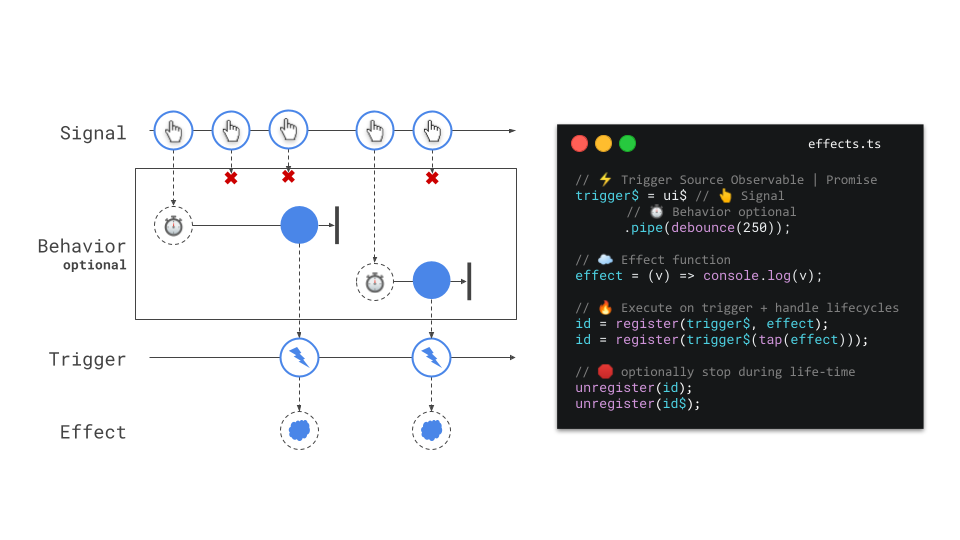Case Study: Refactor to rxEffects
Problem
Let's get the problem it solves into code so we can refactor it.
We start with the side effect and 2 ways to execute it:
@Component({
// ...
})
export class MyComponent {
// The side effect (`console.log`)
private effectFn = (num: number) => console.log('number: ' + num);
// The interval triggers our function including the side effect
private trigger$ = interval(1000);
constructor() {
// [#1st approach] The subscribe's next callback it used to wrap and execute the side effect
this.trigger$.subscribe(this.effectFn);
// [#2nd approach] `tap` is used to wrap and execute the side effect
this.trigger$.pipe(tap(this.effectFn)).subscribe();
}
}
As we introduced a memory leak we have to setup some boilerplate code to handle the cleanup logic:
import { takeUntilDestroyed } from '@angular/core/rxjs-interop';
@Component({
// ...
})
export class MyComponent {
// The side effect (`console.log`)
private effectFn = (num: number) => console.log('number: ' + num);
// The interval triggers our function including the side effect
private trigger$ = interval(1000);
constructor() {
this.trigger$.effect$
.pipe(
takeUntilDestroyed()
// ⚠ Notice: Don't put any operator after takeUntil to avoid potential subscription leaks
)
.subscribe(this.effectFn);
}
}
There are already a couple of things that are crucial:
- unsubscribe on destroy
- having the
takeUntiloperator as last operator in the chain
Another way would be using the subscription to run the cleanup logic.
@Component({
// ...
})
export class MyComponent implements OnDestroy {
// The side effect (`console.log`)
private effectFn = (num: number) => console.log('number: ' + num);
// The interval triggers our function including the side effect
private trigger$ = interval(1000);
// ⚠ Notice: The created subscription must be stored to `unsubscribe` later
private readonly subscription: Subscription;
constructor() {
// ⚠ Notice: Never forget to store the subscription
this.subscription = this.trigger$.subscribe(this.effectFn);
}
ngOnDestroy(): void {
// ⚠ Notice: Never forget to cleanup the subscription
this.subscription.unsubscribe();
}
}
Solution
In RxAngular we think the essential problem here is the call to subscribe itself. All Subscriptions need to get unsubscribed manually which most of the time produces heavy boilerplate or even memory leaks if ignored or did wrong.
Like rxState, rxEffects is a local instance created by a component and thus tied to the components life cycle.
We can manage Observables as reactive triggers for side effects or manage Subscriptions which internally hold side effects.
To also provide an imperative way for developers to unsubscribe from the side effect register returns an "asyncId" similar to setTimeout.
This can be used later on to call unregister and pass the async id retrieved from a previous register call. This stops and cleans up the side effect when invoked.
As an automatism any registered side effect will get cleaned up when the related component is destroyed.
Using rxEffects to maintain side-effects
import { rxEffects } from '@rx-angular/state/effects';
@Component({})
export class MyComponent {
// The side effect (`console.log`)
private effectFn = (num: number) => console.log('number: ' + num);
// The interval triggers our function including the side effect
private trigger$ = interval(1000);
private effects = rxEffects(({ register }) => {
register(this.trigger$, this.effectFn);
});
}
⚠ Notice: Avoid calling
register,unregister,subscribeinside the side-effect function. (here nameddoSideEffect)
Impact

Compared to common approaches rxEffects does not rely on additional decorators or operators.
In fact, it removes the necessity of the subscribe.
This results in less boilerplate and a good guidance to resilient and ergonomic component architecture. Furthermore, the optional imperative methods help to glue third party libs and a mixed but clean code style in Angular.